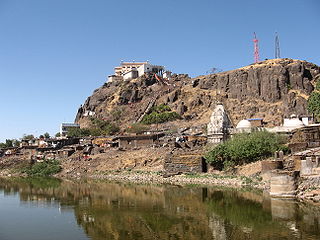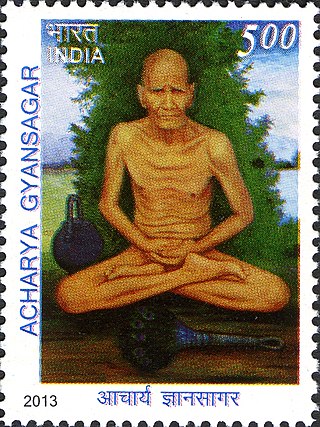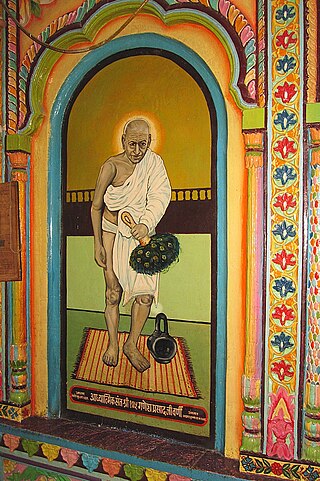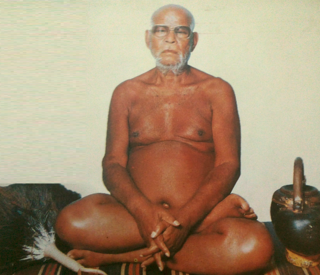Acharya Aryanandi was a prominent Jain monk of the early 20th century. He is best known for his work in establishing several Jain schools in the Indian state of Maharashtra. Several Jain monks before him have also been named Aryanandi.
Paryushana is an annual holy event for Jains and is usually celebrated in August, September or October in Hindi calendar Bhadrapad Month's Shukla Paksha. Jains increase their level of spiritual intensity often using fasting and prayer/meditation to help. The five main vows are emphasized during this time. There are no set rules, and followers are encouraged to practice according to their ability and desires. The event lasts for 8 or 10 days, and ends with the celebration of Samvatsari.

Acharya Vidyasagar was an influential Indian Digambara Jain acharya (monk), credited with having brought about a revival in educational and religious activities in Digambara Jainism. He wrote the epic Hindi poem Mukamati.

Acharya Shri Mahapragya was the tenth head of the Śvetāmbara Terapanth order of Jainism. Mahapragya was a saint, yogi, spiritual leader, philosopher, author, orator, and poet.

Acharya Shri Shantisagar Ji (1872–1955) was an Indian Acharya of the Digambara monk faith. He was the first Acharya (preceptor) and a leader of his digamber sect in the 20th century. Shanti Sagar ji revived the teaching and practice of traditional Digambara practices in North India. He was lustrated as a kshullaka into the Sangha by Devappa (Devakirti) Swami Ji. He took his ailaka deeksha before an image of the Tirthankara Neminatha. In about 1920, Shantisagar Ji became a full muni (sadhu) of the Digambara. In 1922, at Yarnal village, Belgaum district, Karnataka, he was given the name "Shanti Sagar Ji".

Pavagadh is a municipal operated region in Panchmahal district about 46 kilometres (29 mi) away from Vadodara in Gujarat state in western India. It is known for a famous Mahakali temple which is one of the 51 Shaktipeeths and draws thousands of pilgrims every day. However, as per records, this was originally a Jain temple belonging to the Svetambara Achalgaccha sect, whose Adhistayika Mahakali's idol was installed here in the 12th century. This locality Champaner-Pavagadh Archaeological Park was declared by UNESCO as a World Heritage Site in 2004.

Nemawar is a small town in Dewas District, Madhya Pradesh, India. Nemawar is located on the left bank of the Narmada river opposite to Handia. However, it belongs to Khategaon block and tehsil of the Dewas district

Acharya Vijay Vallabhsuri was a Jain monk. He was a disciple of Vijayanandsuri. He worked in Punjab so he was given honorific Punjab Kesari.

Acharya Jnansagar or Gyansagar (1891–1973) was a Digambara Jain Acharya of 20th century who composed many Sanskrit epics. He initiated Acharya Vidyasagar in 1968 as a monk and 1972 as an Acharya.

Anand Rishiji Maharaj was a Jain religious leader. The Government of India issued a commemorative postage stamp in his honour on 9 August 2002. He was awarded with the honorary title of Rashtra Sant by Maharashtra's chief minister. He was the Second Aacharya of Vardhaman Sthanakvasi Shraman Sangha

Kshullak Ganeshprasad Varni was one of the foundational figures of the modern Indian Digambara intellectual tradition during the early 20th century. He was the founder of several schools and institutions of advanced learning including Syadvad Mahavidyalaya at Varanasi in 1905, Varanasi and Satark-Sudhataringini Digamber Jain Pathshala, now Ganesh Digamber Jain Sanskrit Vidyalaya at Sagar.

Muni Tarun Sagar was an Indian Digambara monk. His lectures are termed Kadve Pravachan because they can be candidly critical of common practices and views. His lectures have been compiled and published in book series also titled Kadve Pravachan. Excerpts from his discourses are often published by newspapers. Unlike most other Digambar Jain monks, his audience often included a majority of non-Jains. His discourses often addressed family or society issues.

The Statue of Vasupujya located at Champapur,Bhagalpur in the Indian state of Bihar, is one of the tallest statues in eastern India and the tallest statue of Lord Vasupujya in India. The statue is dedicated to Vasupujya, the twelfth Jain Tirthankara of the present cosmic age. The height of the statue is 31 ft. The statue was constructed and donated by Smt Sona Devi Sethi Charitable trust, Nagaland. Champapur is a Siddhakshetra and occupies a very significant place among the Jains. This is said to be the place where all the five kalyanaks - Garbh, Janam, Diksha, Kevalgyana and Moksh kalyanak of Tirthankara Vasupujya took place. It is said that the first tirthankar Rishabha, twenty-third Tirthankara Parshvanath and last tirthankara Mahavira had their Chaturmas at this place. Mahavira had his third and twelfth Chaturmas at this place.

Acharya Deshbhushan was a Digambara Jain Acharya of 20th century who composed and translated many Kannada scriptures to Hindi and Sanskrit. He initiated and elevated several Jain monks and nuns like Shwetpichhi Acharya Vidyananda ji and Gyanmati Mataji. He is renowned for his remarkable translations of Kannada scriptures to Sanskrit and Hindi. He is the first Digambara Acharya to visit and address the Indian Parliament in the year 1974 along with the Prime Minister Indira Gandhi.

Muni Shri 108 Kshamasagar ji Maharaj was a Digambara monk initiated by Shri 108 Acharya Vidyasagar ji Maharaj. He is also known for his poetry and writings which are widely quoted.

Nainagiri is a major pilgrimage site for Jainism in India. It is located in the central Indian state of Madhya Pradesh, it is 12 km from Dalpatpur and 25 km from Bukswaha. This tirth, also known as Reshandigiri, is a Siddha Kshetra where five ancient saints including Varadatta had attained nirvana.

Bade Baba Temple, Kundalpur is a temple in Kundalpur, a pilgrimage town for Jains, in Damoh district of Madhya Pradesh. It is 35 km from Damoh. The Bade Baba Temple was formally known as Shri Digamber Jain Siddha Kshetra Kundalpur.

Śvetāmbara Terapanth is a sect of the Śvetāmbara Jainism that was founded by Acharya Bhikshu in Vikram Samvat 1817. Acharya Bhikshu believed in strict adherence to the canonical code of conduct for ascetics as prescribed by Lord Mahavira. Acharya Bhikshu rigorously followed the principles and thus set an example for all to follow. He showed the way for the life of discipline, purity and self-control.

Beenaji or Beena Barha is a Jain temples loceted in Sagar District of Madhya Pradesh. The temple are located near Deori Kalan City.


















